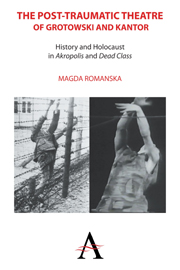 The Post-traumatic Theatre of Grotowski and Kantor
The Post-traumatic Theatre of Grotowski and Kantor Book contents
- Frontmatter
- Contents
- Foreword by Kathleen Cioffi
- Preface
- Acknowledgments
- List of Illustrations
- Introduction
- Part I Our Auschwitz: Grotowski's Akropolis
- Part II Our Memory: Kantor's Dead Class
- Chapter 22 Tadeusz Kantor: A Very Short Introduction
- Chapter 23 Dead Class: The Making of the Legend
- Chapter 24 Dead Class in Poland
- Chapter 25 The Polish History Lesson
- Chapter 26 Dead Class Abroad
- Chapter 27 On Not Knowing Polish, Again
- Chapter 28 The Visual and the Puerile
- Chapter 29 The National and the Transnational
- Chapter 30 Witkiewicz's Tumor
- Chapter 31 An Age of Genius: Bruno Schulz and the Return to Childhood
- Chapter 32 Conversing with Gombrowicz: The Dead, the Funny, the Sacred and the Profane
- Chapter 33 Panirony: “A pain with a smile and a shrug”
- Chapter 34 Raising the Dead
- Chapter 35 Dead Class as Kaddish…
- Chapter 36 Dead Class as Dybbuk, or the Absence
- Chapter 37 The Dead and the Marionettes
- Chapter 38 Men and Objects
- Chapter 39 Dead Class as Forefathers' Eve
- Chapter 40 Dead Class: The Afterlife
- Postscript
- Appendix
- Notes
- Bibliography
- Index
Chapter 37 - The Dead and the Marionettes
from Part II - Our Memory: Kantor's Dead Class
- Frontmatter
- Contents
- Foreword by Kathleen Cioffi
- Preface
- Acknowledgments
- List of Illustrations
- Introduction
- Part I Our Auschwitz: Grotowski's Akropolis
- Part II Our Memory: Kantor's Dead Class
- Chapter 22 Tadeusz Kantor: A Very Short Introduction
- Chapter 23 Dead Class: The Making of the Legend
- Chapter 24 Dead Class in Poland
- Chapter 25 The Polish History Lesson
- Chapter 26 Dead Class Abroad
- Chapter 27 On Not Knowing Polish, Again
- Chapter 28 The Visual and the Puerile
- Chapter 29 The National and the Transnational
- Chapter 30 Witkiewicz's Tumor
- Chapter 31 An Age of Genius: Bruno Schulz and the Return to Childhood
- Chapter 32 Conversing with Gombrowicz: The Dead, the Funny, the Sacred and the Profane
- Chapter 33 Panirony: “A pain with a smile and a shrug”
- Chapter 34 Raising the Dead
- Chapter 35 Dead Class as Kaddish…
- Chapter 36 Dead Class as Dybbuk, or the Absence
- Chapter 37 The Dead and the Marionettes
- Chapter 38 Men and Objects
- Chapter 39 Dead Class as Forefathers' Eve
- Chapter 40 Dead Class: The Afterlife
- Postscript
- Appendix
- Notes
- Bibliography
- Index
Summary
In Dead Class, Kantor is interested in representing absence, and he does so by two aesthetic means: one, he places his actors on an equal footing with objects, thus creating his bio-objects, combinations of actor and object; and two, he models his actors on marionettes. Dead Class, however, wasn't the first work in which he explored these concepts. Kantor used mannequins in The Water Hen (1976) and The Shoemakers (1970). In his staging of Słowacki's Balladyna, Kantor had mannequins as doubles of the real actors.
In modeling his actors on marionettes, Kantor was partially influenced by the theories of Heinrich von Kleist and Edward Gordon Craig. In a pivotal essay written in 1810, “About the Marionette Theater,” Kleist introduces the idea of the intrinsic supremacy of the puppet over the human actor. On an ontological scale, Kleist locates man somewhere between God, the supreme being, and the marionette, the absence of being, both of which represent similar degrees of perfection as complete opposites of each other. The marionette's lack of consciousness and the centralization of all of its movements from one point of gravity make it an absolute and finished form, one for which nothing can be improved. Because all the puppet's movements are controlled from one point, it can be fully coordinated, creating the sort of ultimate, divine grace attainable only by that other perfection, God. For Kleist, marionettes “are members of only one world, responding ‘naturally’ and ‘gracefully’ to divine guidance. This is underscored by their apparent weightlessness.
- Type
- Chapter
- Information
- The Post-traumatic Theatre of Grotowski and KantorHistory and Holocaust in 'Akropolis' and 'Dead Class', pp. 262 - 266Publisher: Anthem PressPrint publication year: 2012


